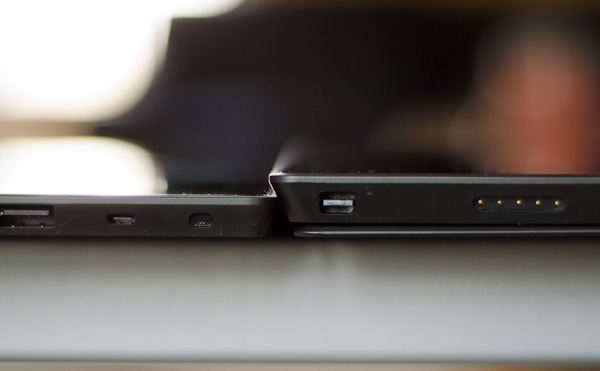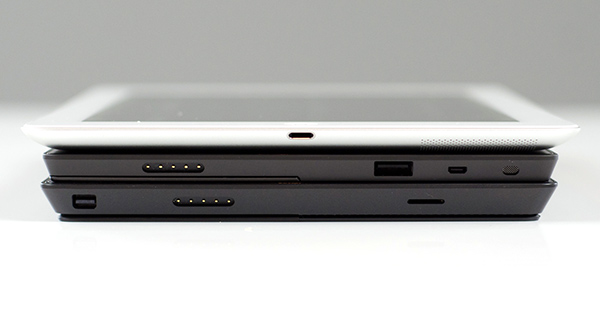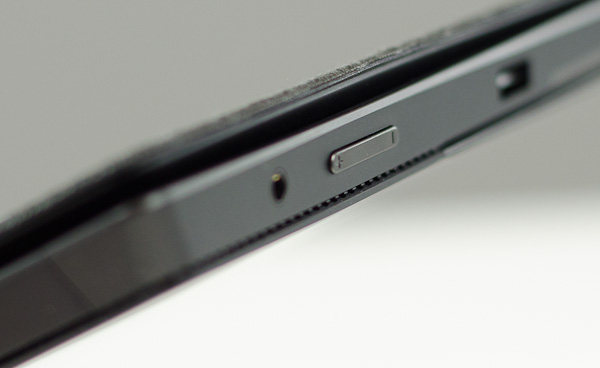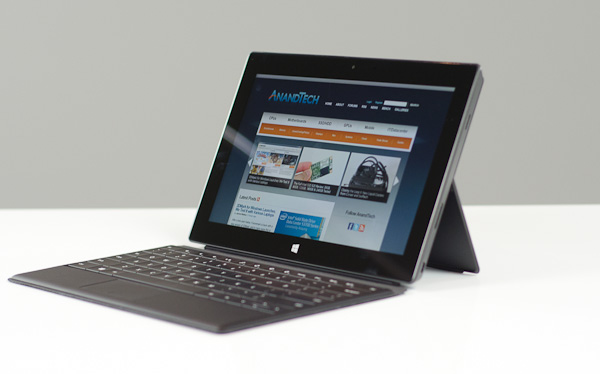Microsoft Surface Pro Review
by Anand Lal Shimpi on February 5, 2013 9:00 PM ESTSurface Pro Design
When I first saw Surface Pro, the Microsoft rep giving me the demo did a simple test. He stood Surface Pro right next to Surface, with the same start screen, and asked me if I could tell the two apart. The planar dimensions of Surface Pro are identical to Surface RT. Both feature the same sized 10.6-inch display, the same capacitive Windows button and the same 1-inch border around the screen. Looking head on, the only way you can tell the difference between Surface Pro and RT is the former’s 1080p display does make text a bit sharper.

Surface RT (left) vs Surface Pro (right)
Turn the two tablets to the side and the differences quickly become evident. Surface Pro is over 40% thicker than Surface RT (13.7mm vs 9.3mm). While the latter was of a similar thickness to an iPad with Retina Display, Surface Pro is clearly in a different league of dimensions.
The thickness of Surface Pro doesn’t really impede its portability, but the weight definitely makes it a lot less pleasant to carry around. Surface RT was already heavier than the competition but it hid its weight well. Surface Pro is just heavy for a tablet. I wasn’t originally impressed by the Surface RT form factor, but in switching between the RT and Pro models I immediately wish that Surface Pro came in the RT chassis and Surface RT came in something even thinner and lighter.

Surface Pro (left) vs. iPad 4 (right)

From top to bottom: iPad 4, Surface RT and Surface Pro
Shift the comparison to Ultrabooks however and all of the sudden Surface Pro seems quite light. It’s lighter than an 11-inch MacBook Air and Acer’s 11.6-inch Aspire S7 (although with optional keyboard cover it is heavier). It’s all about perspective. Compared to an iPad, Surface Pro is heavy, but compared to an Ultrabook or MacBook Air it’s light. The Pro model embodies the vision Microsoft had for the Surface family: to create a new type of device somewhere between a tablet and a notebook. That’s not to say there’s not room for improvement in the physical department. Surface Pro will likely go on a diet as it’s given more power efficient silicon, but even then you’ll always be able to build something thinner and lighter based on slower hardware, or go thicker and heavier with a notebook.
The fit and finish of Surface Pro are just as good as Surface RT. The tablet is built out of the same injection moulded Magnesium process (VaporMg) as Surface RT, however the chassis itself is somewhat simplified. While Surface RT featured three discrete VaporMg components (frame, back and kickstand), Surface Pro is made up of only two (single piece frame+back and kickstand). The result is no different to the end user, but the simplification on the assembly side is likely better for Microsoft.
I am fine laying the same praise on Surface Pro’s build quality as I did on Surface RT. The unique finish doesn’t feel like the aluminum we’re used to seeing on iPads, and definitely feels better than the plastic we’ve seen elsewhere. The VaporMg surface doesn’t feel like it would scratch easily, and after a few months with Surface RT I don’t see any visible scratches on my unit.
Surface Pro’s construction feels more utilitarian and understandably more oriented towards productivity, just like its little brother. I still believe that the Surface lineup is as much about Microsoft showing that it too can build high quality devices as it is about getting into the tablet market. If we compare it to the iPad, Surface Pro feels just as well built, if we compare it to every Windows RT and Windows 8 tablet or notebook on the market today - it’s worlds better. Say what you will about Microsoft entering the PC hardware business, but as of today Microsoft builds the best Windows RT and Windows 8 hardware on the market. If I ran a PC OEM I wouldn’t be angry at Microsoft, I’d be angry at myself for letting this happen.
Surface Pro retains the integrated kickstand from Surface RT, although the kickstand has been beefed up to accommodate the heavier tablet. Surface Pro’s kickstand keeps the device propped up at a fixed angle of 26-degrees away from the vertical axis. The rear facing camera is also angled to compensate (it shoots parallel to the ground with the kickstand opened).
The kickstand is allegedly good for over a million open/close cycles and it still doesn’t feel like something that would break. There are only two hinges in the kickstand compared to three for the RT model.
The kickstand on Surface Pro feels different than the kickstand on Suface RT. The Pro kickstand feels lighter and sounds less like metal and more like plastic if you tap on it. Feel around on the underside of the kickstand and you’ll notice a coating that seems to dampen sound and perhaps add some structure reinforcement to the design. Microsoft had to thicken the kickstand to support the added weight of the Surface Pro, but the difference is on the order of a fraction of a millimeter.
The tweaked kickstand does have different acoustics than Surface RT’s kickstand. While the latter sounded a lot like a thin metal door shutting, the Pro’s kickstand is far more muffled. I’d almost say it’s preferable.
Thankfully the kickstand’s functionality hasn’t been marginalized in the transition to the Pro. It’s still a highly integrated and very important part of the Surface experience. It’s simple to flip out and perfect for use on desks. You can make the kickstand work on your lap or chest if you’re lying down, but it’s not ideal for either unfortunately.
The more I use Surface (Pro and RT) the more I feel that Microsoft needs to pursue something a bit more flexible than the fixed 26-degree kickstand. The biggest issue by far is in-lap use with one of the keyboard covers attached. Depending on your seating position, the 26-degree angle that the kickstand opens at might be too small. Mechanically I don’t know the right solution for Microsoft but I do feel like for the kickstand to realize its true potential, it needs to be able to open and hold at multiple angles. It doesn’t necessarily need to have support for infinite angles, maybe even a few would work, but I do believe it’s necessary going forward.













228 Comments
View All Comments
piroroadkill - Monday, February 11, 2013 - link
How about they put all the bulk in the keyboard section, attach it permanently, and get rid of the kickstand? That way you could use it anywhere, even on your lap! Sounds much better.Seriously though, this is a painfully awkward gimmick, and I'd much rather have an ultraportable laptop.
Patrice - Monday, February 11, 2013 - link
I'm a prof photograph and film maker. I use my PCs with adobe production suite and other sotfwares. I have a light version on my laptop too when on a shooting but I thought that the Surface Pro, with a smaller footprint would be the perfect tool as an enhanced monitor and controler (different applications) for my cameras. My wife received an ipad 4 for Christmas and since then I tried to find a usefull application beyond what a 15 year old would do with the thing unfortunately I'm still on the quest of findings something productive (work related) beside converting my ipad into a slate (which I don't need) or a remote control for my tv or my pc.The surface pro looks like a good, (I do not intent to edit or do any post prod on it) idea but if I understand correctly the product has the same disease as the ipad stuff; no video input! I understand Apple's business model to brickwall the user whitin the "I"universe but MS? Why can't I use the Surface as a monitor? After all it offers more than decent quality? Why should it be limited to an AV output??? If my understanding of the product is right, that's a big no no for me, I'm still stuck with a laptop.
The battery drama is real only when you compare the product with non-computer product like Android and the i stuff, I do not have any problem with that as I have a ton of very good batteries that will power the Surface for a long time except that I would need a 12vdc charger (lighter plug) that is not offer on MS shop.
Why is it that when buyng a $1200 I have less technical details then buying a $10 toater? Tried to get an idea about power consumption; over the battery stuff, there is no info, idle power amps, low work load, heavy. I know it depends but would be easy to set a minimum and maximum. The point being that this piece of hardware should be used in more remote location and situation for people than needs the power and freedom of use, this is not for the kids chatting on facebook, this is for working people that needs to do the other stuff.
crispbp04 - Wednesday, February 13, 2013 - link
it has a usb3.0 port, how do you not consider that an option for av input?Soda-88 - Monday, February 11, 2013 - link
Does anyone know what type of SSD is in the Surface Pro? Is it replaceable with bigger mSATA drive for example?Soda-88 - Monday, February 11, 2013 - link
Nevermind, just saw this:Update: It looks like the C400 SSD is an mSATA drive, likely similar to the one we reviewed here a while back.
Marq - Tuesday, February 12, 2013 - link
I feel anandtech is spot on with their view of microsofts product: essentially an ultra book with tablet capabilities. If you were to take such a view you'll find the surface pro rather pleasing. It's funny the way some argue against it. They say the androids and ioses can do the same things and are worth more. A 128gb iPad @ 900usd needs an additional Bluetooth keyboard, can't take USB and is stuck at how much it's given. What's the difference? Yes it gets 9hrs of life. But it can't do photoshop; it can't do GIS applicationS it can't do serious video editing. This device and many others like it (Lenovo, Samsung etc) strides the boundary between tablets and ultra book.This and upcoming generations will make mobile computing true. The androids and iPads are stuck by their oses limitations and will never be able to do what this device does (and they are not meant to).
I will seriously consider this over the MacBook Air if I didn't have one already. The life is similar but the surface pro is smaller and comes with a pen to boot.
dijuremo - Tuesday, February 12, 2013 - link
The Samsung ATIV Pro 700 has been out since December of last year packing the same CPU, 4GB of ram and 128GB SSD. Claiming that the Surface Pro is easily the fastest tablet on the market just sounds as if you were paid to write this review....
http://www.samsung.com/us/computer/tablet-pcs/XE70...
JLQ - Tuesday, February 12, 2013 - link
So far I've actually enjoyed using this device except for the fact that there are no WinTab drivers for the Wacom digitizer. That means no pressure sensitivity in many graphics applications like Photoshop and Corel Painter, which is a huge bummer for me. Lisa Gade is the only reviewer that I've seen that discusses this.For now, I'm waiting and seeing if WinTab drivers will be provided in the near future. Otherwise, I'm making do with ArtRage for the time being, given that it supports Microsoft's newer pen API and thus does register pressure-sensitive input. Touch controls (pan, zoom, rotate) are an added plus.
Imaginer - Saturday, March 30, 2013 - link
I agree with you. I too enjoyed light gaming, CADing, and used ArtRage. Corel Painter 12 doesn't support pressure, but finger pinch zoom and two finger rotate works. I do not understand the people saying the better option is making do with price equivalent of a ARM tablet and a laptop.For as I used my Kindle Fire, I wished I can view things as smoothly as my PC and work with it better in terms of input, both hardware and software. I like my Envy 14 1st generation laptop, but I have and still do an awkward disconnect with using my Intros with it. Even placing the digitizer on tip of the Envy's keyboard still is awkward for lap use as I have to remove it for keyboard use.
Hence I am glad and have gotten a Surface Pro. I was considering the Samsung ATIV 700T, but if its keyboard dock was heavier with a second battery and maybe second removable mSATA SSD, I would have picked that instead.
I hope some group, either one, solves the pen capability in Painter (and PhotoShop and others too).
Bytre - Tuesday, February 12, 2013 - link
My 128GB has a samsung mzmpc128hbfu-000mv. AS SSD clocks in at 471.31MB/sec read, 252.33MB/sec write on the sequential test. 89.4GB free out of the box, 110GB total capacity (as measured by c: properties).